Biology Mock Exam Paper with MCQs and Diagrams
VerifiedAdded on 2023/06/18
|21
|3905
|65
AI Summary
This Biology Mock Exam Paper includes multiple choice questions on cell structure, skeletal system, muscle action, endocrine system, immune system, and more. It also includes a diagram labeling exercise on cell structure. The paper can be helpful for students preparing for their biology exams.
Contribute Materials
Your contribution can guide someone’s learning journey. Share your
documents today.
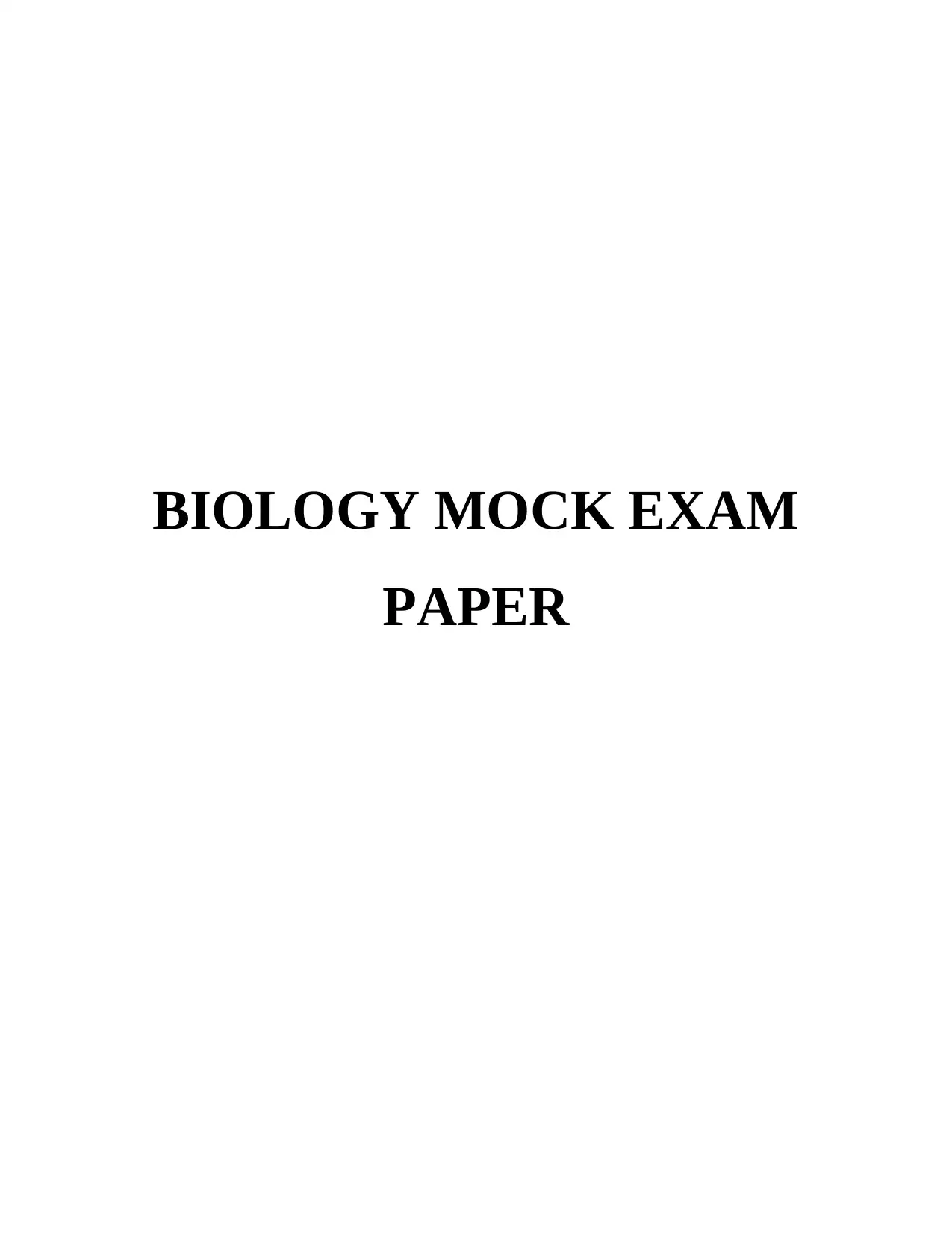
BIOLOGY MOCK EXAM
PAPER
PAPER
Secure Best Marks with AI Grader
Need help grading? Try our AI Grader for instant feedback on your assignments.
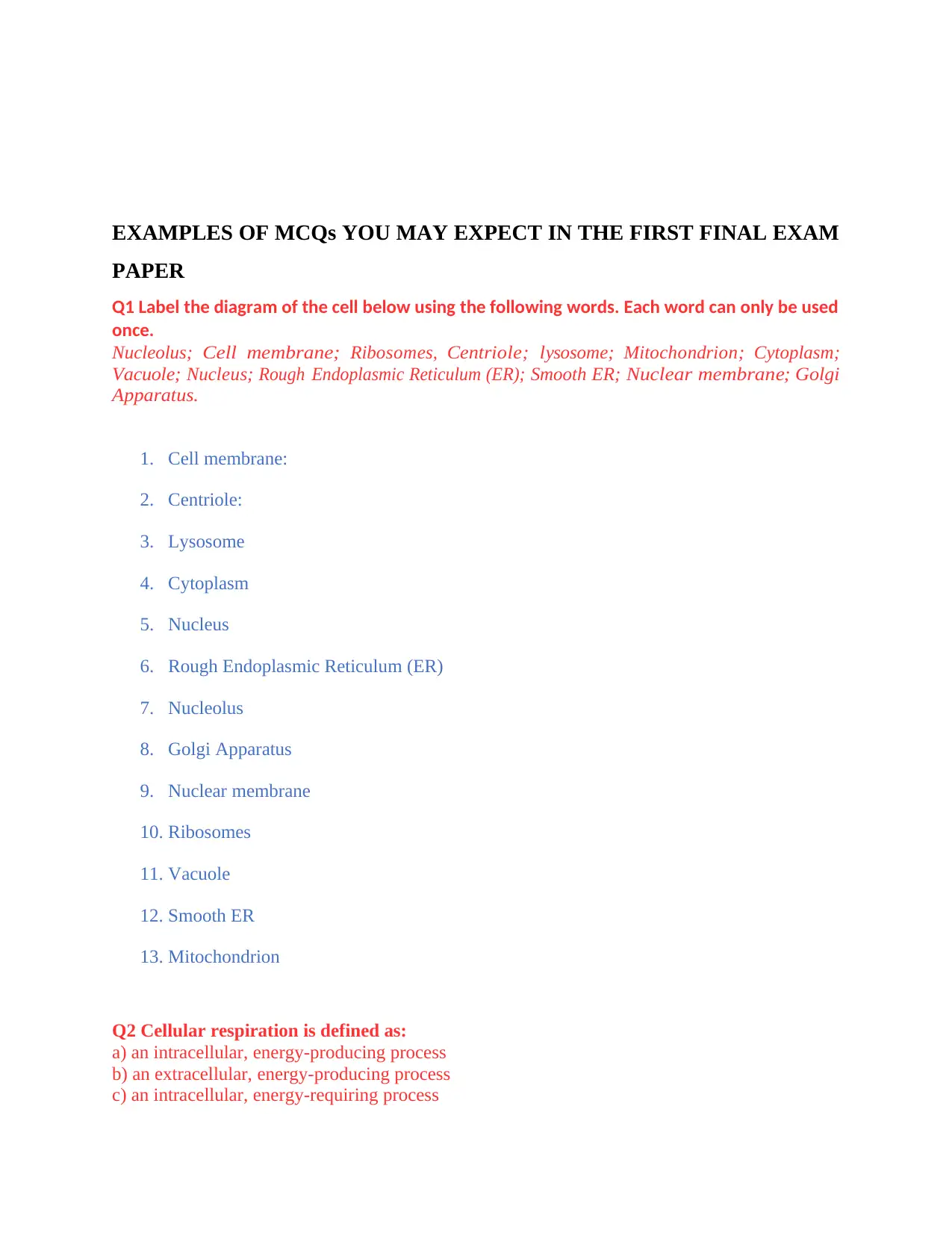
EXAMPLES OF MCQs YOU MAY EXPECT IN THE FIRST FINAL EXAM
PAPER
Q1 Label the diagram of the cell below using the following words. Each word can only be used
once.
Nucleolus; Cell membrane; Ribosomes, Centriole; lysosome; Mitochondrion; Cytoplasm;
Vacuole; Nucleus; Rough Endoplasmic Reticulum (ER); Smooth ER; Nuclear membrane; Golgi
Apparatus.
1. Cell membrane:
2. Centriole:
3. Lysosome
4. Cytoplasm
5. Nucleus
6. Rough Endoplasmic Reticulum (ER)
7. Nucleolus
8. Golgi Apparatus
9. Nuclear membrane
10. Ribosomes
11. Vacuole
12. Smooth ER
13. Mitochondrion
Q2 Cellular respiration is defined as:
a) an intracellular, energy-producing process
b) an extracellular, energy-producing process
c) an intracellular, energy-requiring process
PAPER
Q1 Label the diagram of the cell below using the following words. Each word can only be used
once.
Nucleolus; Cell membrane; Ribosomes, Centriole; lysosome; Mitochondrion; Cytoplasm;
Vacuole; Nucleus; Rough Endoplasmic Reticulum (ER); Smooth ER; Nuclear membrane; Golgi
Apparatus.
1. Cell membrane:
2. Centriole:
3. Lysosome
4. Cytoplasm
5. Nucleus
6. Rough Endoplasmic Reticulum (ER)
7. Nucleolus
8. Golgi Apparatus
9. Nuclear membrane
10. Ribosomes
11. Vacuole
12. Smooth ER
13. Mitochondrion
Q2 Cellular respiration is defined as:
a) an intracellular, energy-producing process
b) an extracellular, energy-producing process
c) an intracellular, energy-requiring process

d) an extracellular, energy-requiring process
c) an intracellular, energy-requiring process
Q3 The main components of the skeletal system are:
a) blood, bones, cartilage, and tendons
b) bones, cartilage, joints, and tendons
c) bones, cartilage, joints, and ligaments
d) cartilage, joints, ligaments, and tendons
b) bones, cartilage, joints, and tendons
Q4 Muscle action can be classified as:
a) sympathetic and parasympathetic
b) voluntary and involuntary
c) autonomic and sympathetic
d) autonomic and voluntary
b) Voluntary and involuntary
Q5 Which system acts as the body’s chemical control centre?
a) endocrine
b) nervous
c) digestive
d) skeletal
a) The gland of endocrine system
Q6 An enzyme is described as a:
a) carbohydrate that slows down reactions
b) protein that slows down reactions
c) carbohydrate that speeds up reactions
d) protein that speeds up reactions
d) protein that speeds up reactions
c) an intracellular, energy-requiring process
Q3 The main components of the skeletal system are:
a) blood, bones, cartilage, and tendons
b) bones, cartilage, joints, and tendons
c) bones, cartilage, joints, and ligaments
d) cartilage, joints, ligaments, and tendons
b) bones, cartilage, joints, and tendons
Q4 Muscle action can be classified as:
a) sympathetic and parasympathetic
b) voluntary and involuntary
c) autonomic and sympathetic
d) autonomic and voluntary
b) Voluntary and involuntary
Q5 Which system acts as the body’s chemical control centre?
a) endocrine
b) nervous
c) digestive
d) skeletal
a) The gland of endocrine system
Q6 An enzyme is described as a:
a) carbohydrate that slows down reactions
b) protein that slows down reactions
c) carbohydrate that speeds up reactions
d) protein that speeds up reactions
d) protein that speeds up reactions
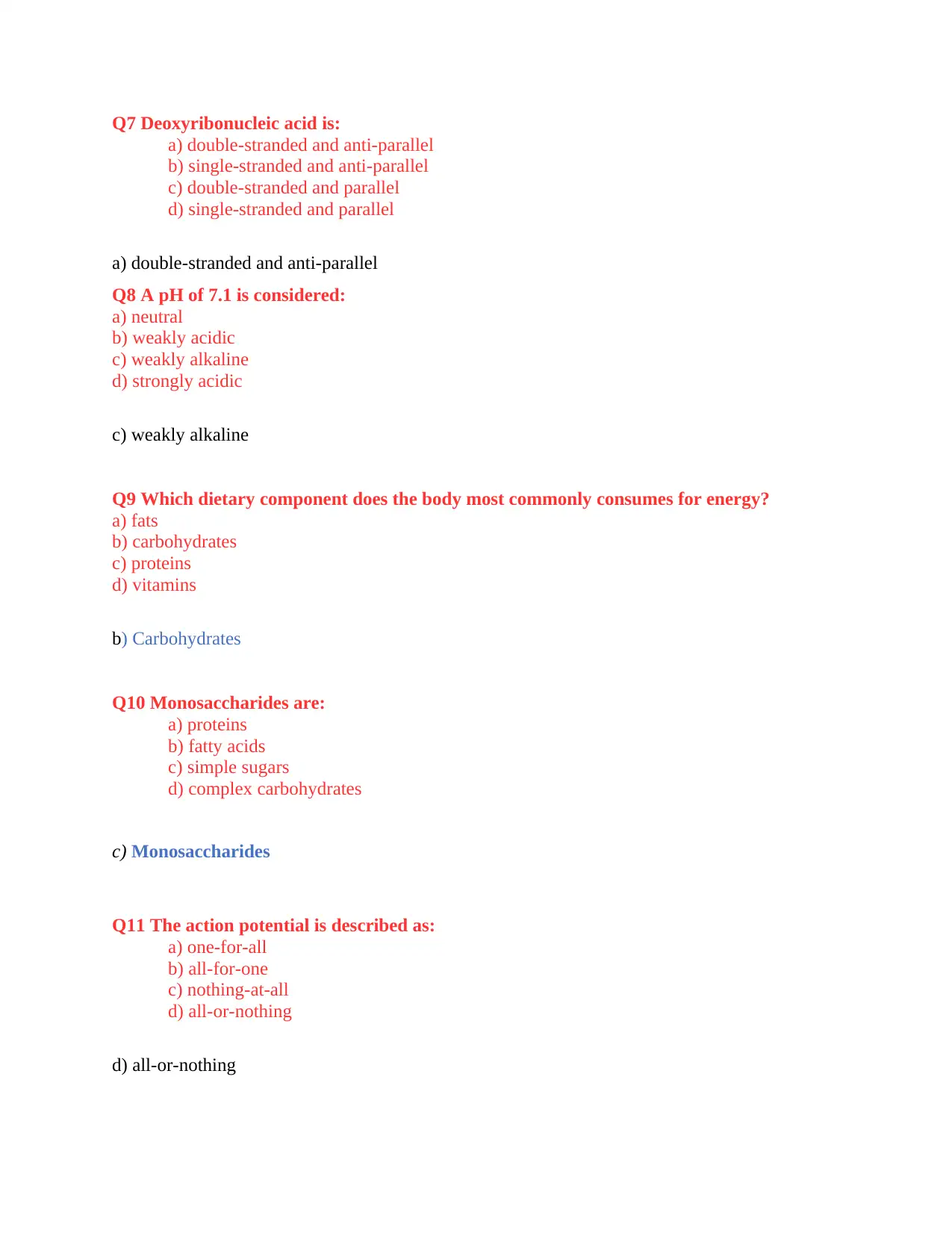
Q7 Deoxyribonucleic acid is:
a) double-stranded and anti-parallel
b) single-stranded and anti-parallel
c) double-stranded and parallel
d) single-stranded and parallel
a) double-stranded and anti-parallel
Q8 A pH of 7.1 is considered:
a) neutral
b) weakly acidic
c) weakly alkaline
d) strongly acidic
c) weakly alkaline
Q9 Which dietary component does the body most commonly consumes for energy?
a) fats
b) carbohydrates
c) proteins
d) vitamins
b) Carbohydrates
Q10 Monosaccharides are:
a) proteins
b) fatty acids
c) simple sugars
d) complex carbohydrates
c) Monosaccharides
Q11 The action potential is described as:
a) one-for-all
b) all-for-one
c) nothing-at-all
d) all-or-nothing
d) all-or-nothing
a) double-stranded and anti-parallel
b) single-stranded and anti-parallel
c) double-stranded and parallel
d) single-stranded and parallel
a) double-stranded and anti-parallel
Q8 A pH of 7.1 is considered:
a) neutral
b) weakly acidic
c) weakly alkaline
d) strongly acidic
c) weakly alkaline
Q9 Which dietary component does the body most commonly consumes for energy?
a) fats
b) carbohydrates
c) proteins
d) vitamins
b) Carbohydrates
Q10 Monosaccharides are:
a) proteins
b) fatty acids
c) simple sugars
d) complex carbohydrates
c) Monosaccharides
Q11 The action potential is described as:
a) one-for-all
b) all-for-one
c) nothing-at-all
d) all-or-nothing
d) all-or-nothing
Secure Best Marks with AI Grader
Need help grading? Try our AI Grader for instant feedback on your assignments.
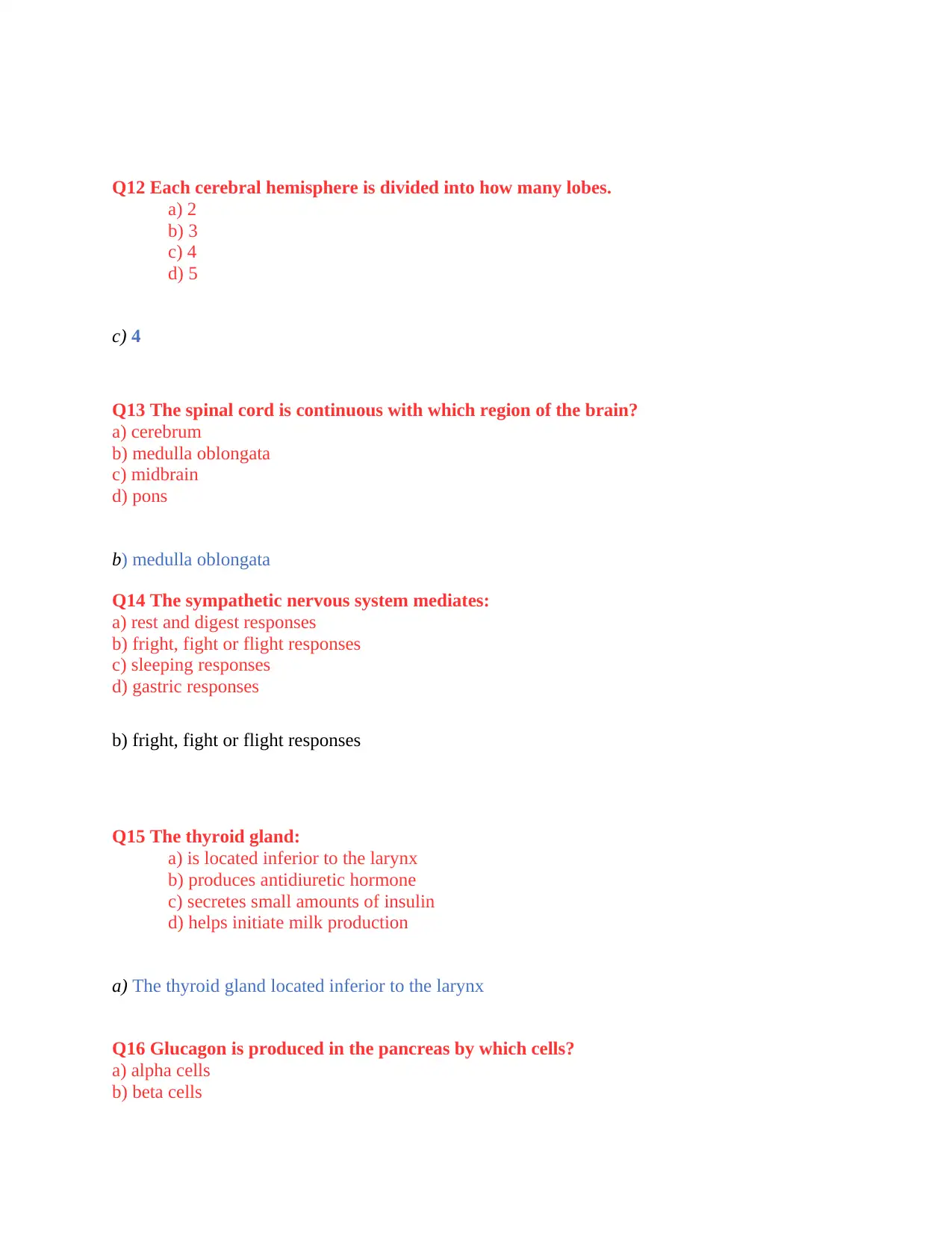
Q12 Each cerebral hemisphere is divided into how many lobes.
a) 2
b) 3
c) 4
d) 5
c) 4
Q13 The spinal cord is continuous with which region of the brain?
a) cerebrum
b) medulla oblongata
c) midbrain
d) pons
b) medulla oblongata
Q14 The sympathetic nervous system mediates:
a) rest and digest responses
b) fright, fight or flight responses
c) sleeping responses
d) gastric responses
b) fright, fight or flight responses
Q15 The thyroid gland:
a) is located inferior to the larynx
b) produces antidiuretic hormone
c) secretes small amounts of insulin
d) helps initiate milk production
a) The thyroid gland located inferior to the larynx
Q16 Glucagon is produced in the pancreas by which cells?
a) alpha cells
b) beta cells
a) 2
b) 3
c) 4
d) 5
c) 4
Q13 The spinal cord is continuous with which region of the brain?
a) cerebrum
b) medulla oblongata
c) midbrain
d) pons
b) medulla oblongata
Q14 The sympathetic nervous system mediates:
a) rest and digest responses
b) fright, fight or flight responses
c) sleeping responses
d) gastric responses
b) fright, fight or flight responses
Q15 The thyroid gland:
a) is located inferior to the larynx
b) produces antidiuretic hormone
c) secretes small amounts of insulin
d) helps initiate milk production
a) The thyroid gland located inferior to the larynx
Q16 Glucagon is produced in the pancreas by which cells?
a) alpha cells
b) beta cells
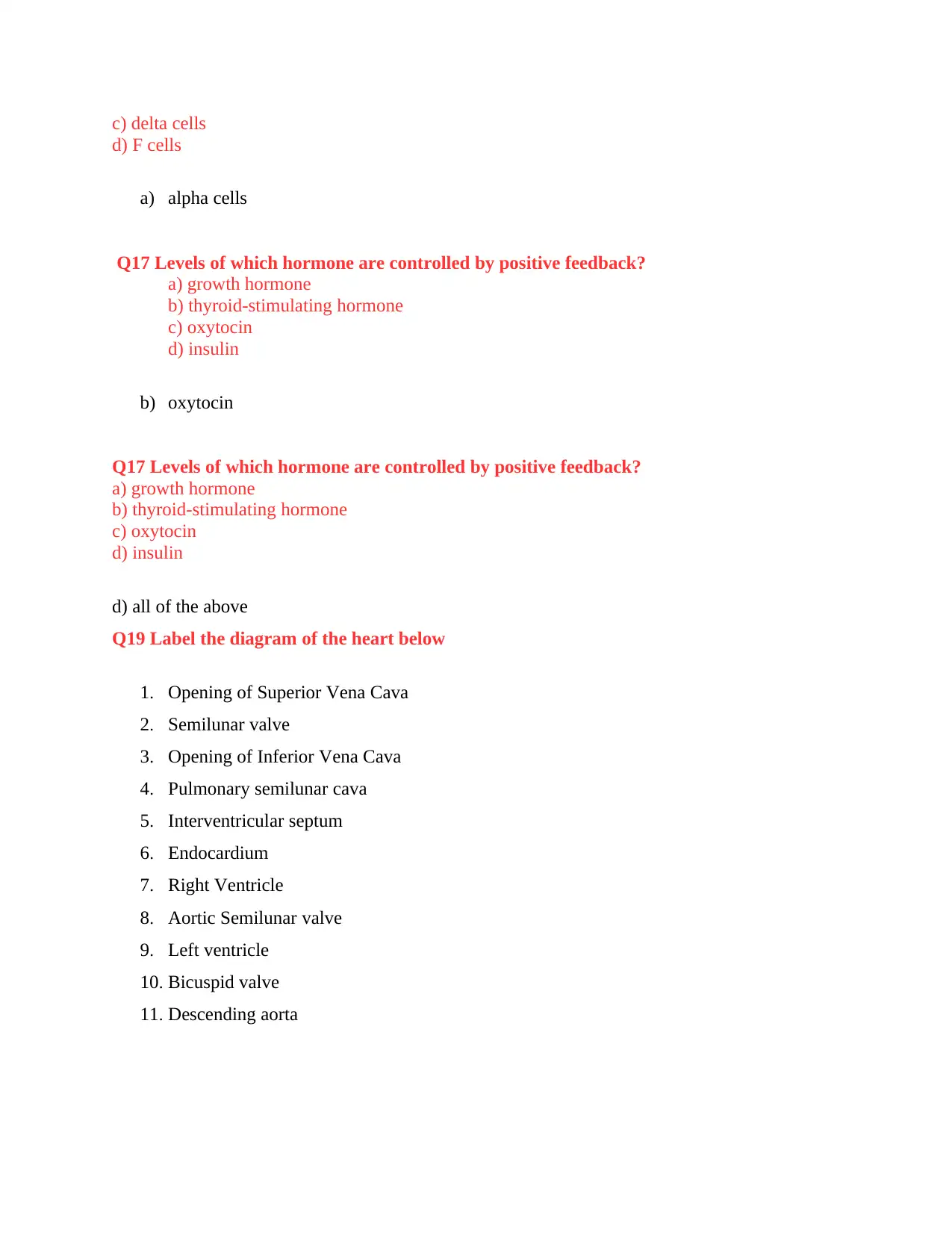
c) delta cells
d) F cells
a) alpha cells
Q17 Levels of which hormone are controlled by positive feedback?
a) growth hormone
b) thyroid-stimulating hormone
c) oxytocin
d) insulin
b) oxytocin
Q17 Levels of which hormone are controlled by positive feedback?
a) growth hormone
b) thyroid-stimulating hormone
c) oxytocin
d) insulin
d) all of the above
Q19 Label the diagram of the heart below
1. Opening of Superior Vena Cava
2. Semilunar valve
3. Opening of Inferior Vena Cava
4. Pulmonary semilunar cava
5. Interventricular septum
6. Endocardium
7. Right Ventricle
8. Aortic Semilunar valve
9. Left ventricle
10. Bicuspid valve
11. Descending aorta
d) F cells
a) alpha cells
Q17 Levels of which hormone are controlled by positive feedback?
a) growth hormone
b) thyroid-stimulating hormone
c) oxytocin
d) insulin
b) oxytocin
Q17 Levels of which hormone are controlled by positive feedback?
a) growth hormone
b) thyroid-stimulating hormone
c) oxytocin
d) insulin
d) all of the above
Q19 Label the diagram of the heart below
1. Opening of Superior Vena Cava
2. Semilunar valve
3. Opening of Inferior Vena Cava
4. Pulmonary semilunar cava
5. Interventricular septum
6. Endocardium
7. Right Ventricle
8. Aortic Semilunar valve
9. Left ventricle
10. Bicuspid valve
11. Descending aorta
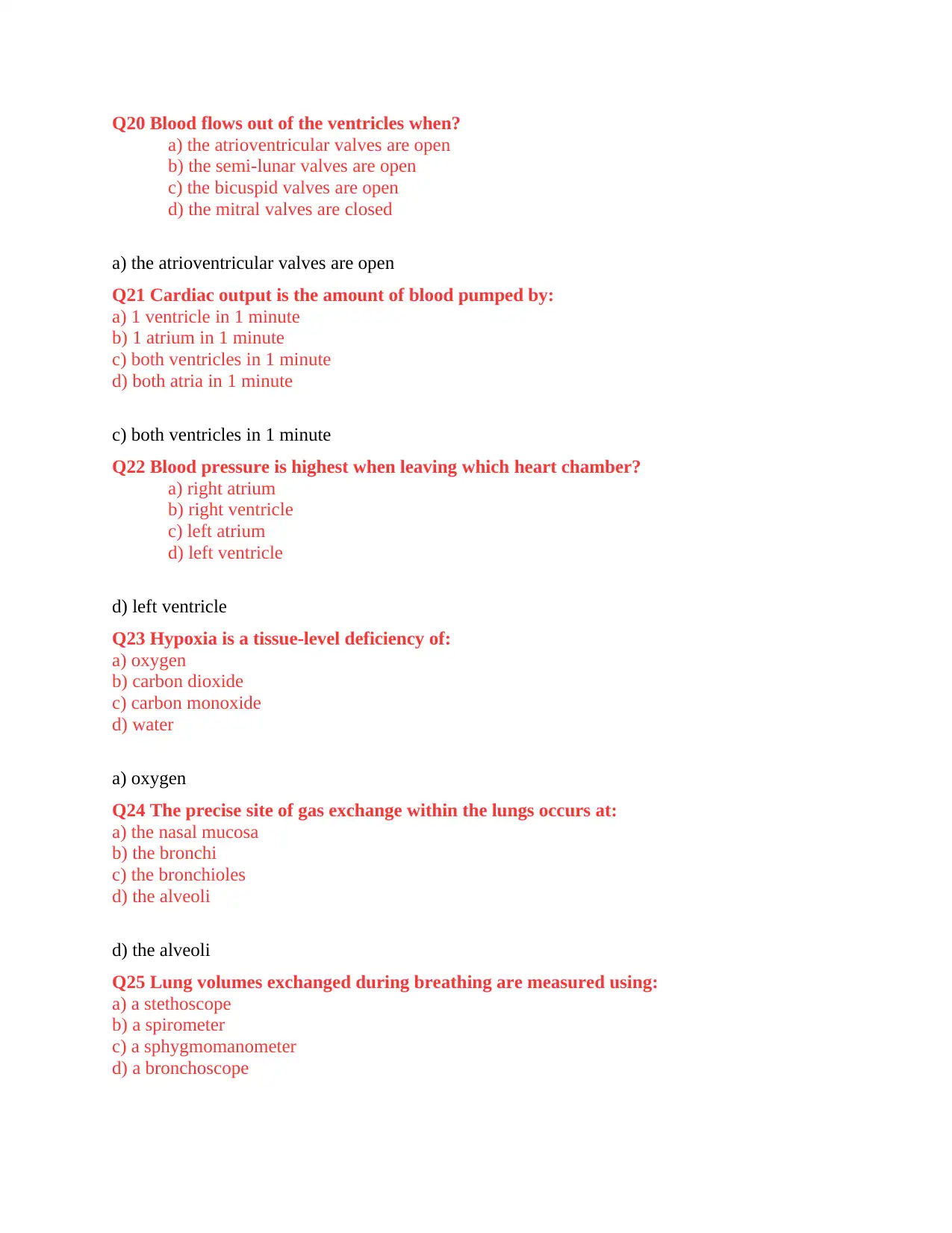
Q20 Blood flows out of the ventricles when?
a) the atrioventricular valves are open
b) the semi-lunar valves are open
c) the bicuspid valves are open
d) the mitral valves are closed
a) the atrioventricular valves are open
Q21 Cardiac output is the amount of blood pumped by:
a) 1 ventricle in 1 minute
b) 1 atrium in 1 minute
c) both ventricles in 1 minute
d) both atria in 1 minute
c) both ventricles in 1 minute
Q22 Blood pressure is highest when leaving which heart chamber?
a) right atrium
b) right ventricle
c) left atrium
d) left ventricle
d) left ventricle
Q23 Hypoxia is a tissue-level deficiency of:
a) oxygen
b) carbon dioxide
c) carbon monoxide
d) water
a) oxygen
Q24 The precise site of gas exchange within the lungs occurs at:
a) the nasal mucosa
b) the bronchi
c) the bronchioles
d) the alveoli
d) the alveoli
Q25 Lung volumes exchanged during breathing are measured using:
a) a stethoscope
b) a spirometer
c) a sphygmomanometer
d) a bronchoscope
a) the atrioventricular valves are open
b) the semi-lunar valves are open
c) the bicuspid valves are open
d) the mitral valves are closed
a) the atrioventricular valves are open
Q21 Cardiac output is the amount of blood pumped by:
a) 1 ventricle in 1 minute
b) 1 atrium in 1 minute
c) both ventricles in 1 minute
d) both atria in 1 minute
c) both ventricles in 1 minute
Q22 Blood pressure is highest when leaving which heart chamber?
a) right atrium
b) right ventricle
c) left atrium
d) left ventricle
d) left ventricle
Q23 Hypoxia is a tissue-level deficiency of:
a) oxygen
b) carbon dioxide
c) carbon monoxide
d) water
a) oxygen
Q24 The precise site of gas exchange within the lungs occurs at:
a) the nasal mucosa
b) the bronchi
c) the bronchioles
d) the alveoli
d) the alveoli
Q25 Lung volumes exchanged during breathing are measured using:
a) a stethoscope
b) a spirometer
c) a sphygmomanometer
d) a bronchoscope
Paraphrase This Document
Need a fresh take? Get an instant paraphrase of this document with our AI Paraphraser
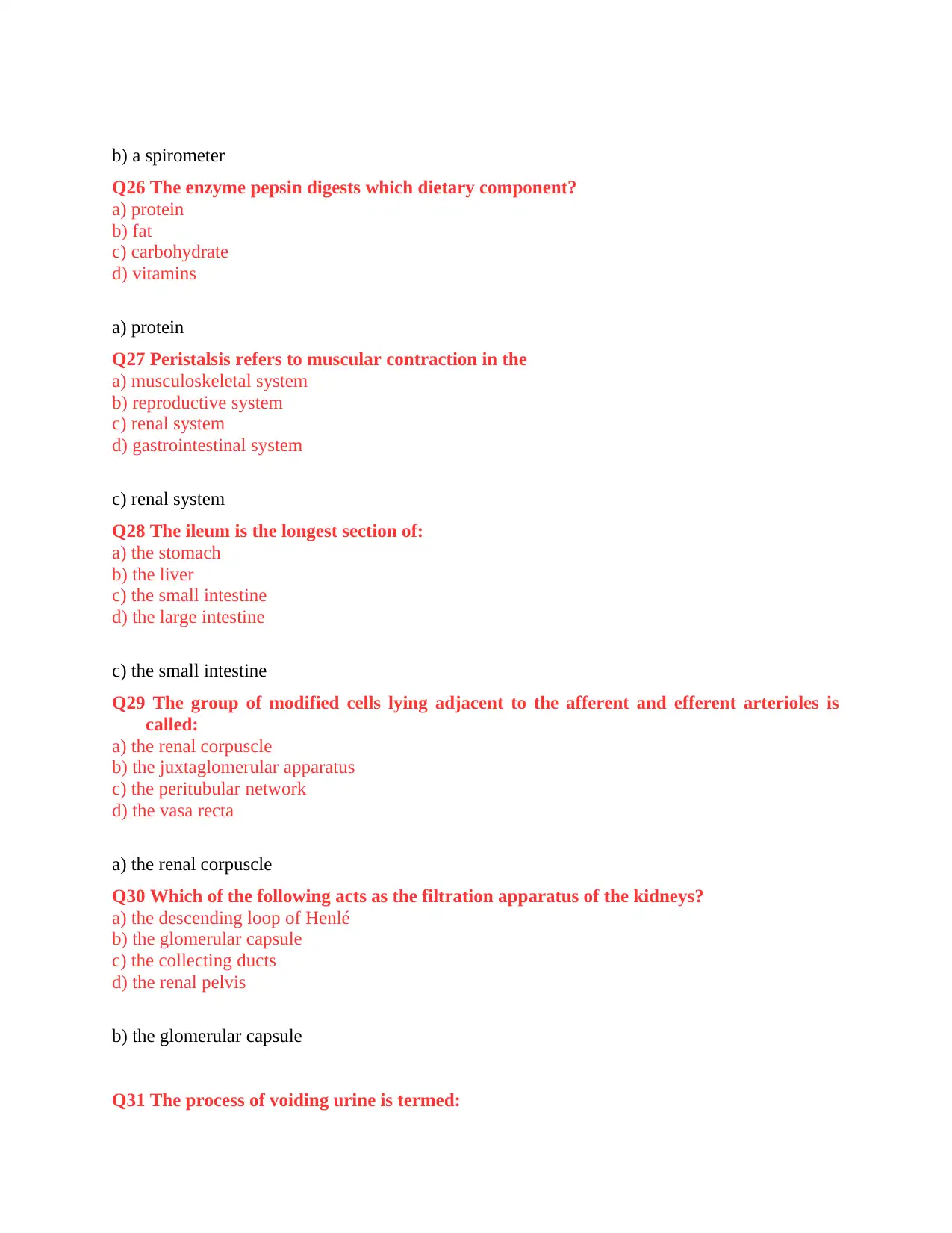
b) a spirometer
Q26 The enzyme pepsin digests which dietary component?
a) protein
b) fat
c) carbohydrate
d) vitamins
a) protein
Q27 Peristalsis refers to muscular contraction in the
a) musculoskeletal system
b) reproductive system
c) renal system
d) gastrointestinal system
c) renal system
Q28 The ileum is the longest section of:
a) the stomach
b) the liver
c) the small intestine
d) the large intestine
c) the small intestine
Q29 The group of modified cells lying adjacent to the afferent and efferent arterioles is
called:
a) the renal corpuscle
b) the juxtaglomerular apparatus
c) the peritubular network
d) the vasa recta
a) the renal corpuscle
Q30 Which of the following acts as the filtration apparatus of the kidneys?
a) the descending loop of Henlé
b) the glomerular capsule
c) the collecting ducts
d) the renal pelvis
b) the glomerular capsule
Q31 The process of voiding urine is termed:
Q26 The enzyme pepsin digests which dietary component?
a) protein
b) fat
c) carbohydrate
d) vitamins
a) protein
Q27 Peristalsis refers to muscular contraction in the
a) musculoskeletal system
b) reproductive system
c) renal system
d) gastrointestinal system
c) renal system
Q28 The ileum is the longest section of:
a) the stomach
b) the liver
c) the small intestine
d) the large intestine
c) the small intestine
Q29 The group of modified cells lying adjacent to the afferent and efferent arterioles is
called:
a) the renal corpuscle
b) the juxtaglomerular apparatus
c) the peritubular network
d) the vasa recta
a) the renal corpuscle
Q30 Which of the following acts as the filtration apparatus of the kidneys?
a) the descending loop of Henlé
b) the glomerular capsule
c) the collecting ducts
d) the renal pelvis
b) the glomerular capsule
Q31 The process of voiding urine is termed:

a) menstruation
b) filtration
c) micturition
d) fibrillation
c) micturition
Q32 Normal urine:
a) is usually alkaline
b) contains approximately 75 per cent water
c) has a specific gravity around 1.001–1.035
d) has a high protein content
c) has a specific gravity around 1.001–1.035
Q33 The immune system can be classified into two main categories:
a) humoral and cell-mediated
b) specific and non-specific
c) specific and humoral
d) cell-mediated and specific
b) specific and non-specific
Q34 What is the first line of defence in any immune response?
a) anatomical, mechanical, and chemical barriers
b) B- and T-lymphocytes
c) antibodies
d) macrophages
d) macrophages
Q35 Which blood group can be transfused into an O Rh- patient?
a) O Rh-
b) O Rh+
c) AB Rh+
d) AB Rh-
a) O Rh
Q36 Antibodies are formed from which white blood cell?
a) neutrophil
b) basophil
c) B-lymphocyte
b) filtration
c) micturition
d) fibrillation
c) micturition
Q32 Normal urine:
a) is usually alkaline
b) contains approximately 75 per cent water
c) has a specific gravity around 1.001–1.035
d) has a high protein content
c) has a specific gravity around 1.001–1.035
Q33 The immune system can be classified into two main categories:
a) humoral and cell-mediated
b) specific and non-specific
c) specific and humoral
d) cell-mediated and specific
b) specific and non-specific
Q34 What is the first line of defence in any immune response?
a) anatomical, mechanical, and chemical barriers
b) B- and T-lymphocytes
c) antibodies
d) macrophages
d) macrophages
Q35 Which blood group can be transfused into an O Rh- patient?
a) O Rh-
b) O Rh+
c) AB Rh+
d) AB Rh-
a) O Rh
Q36 Antibodies are formed from which white blood cell?
a) neutrophil
b) basophil
c) B-lymphocyte

d) monocyte
c) B-lymphocyte
Q37 Compared to a primary immune response, a secondary response is described as:
a) slower and less intense
b) faster but less intense
c) slower but more intense
d) faster and more intense
d) faster and more intense
Q38 In males, testosterone is produced by:
a) the interstitial cells
b) the seminiferous tubules
c) the epididymis
d) the vas deferens
a) the interstitial cells
Q39 Where does fertilization of an ovum by sperm usually take place?
a) in the fallopian tube
b) in the vagina
c) in the uterus
d) in the ovary
a) in the fallopian tube
Q40 The onset of reproductive age is termed:
a) menstruation
b) menarche
c) menopause
d) puberty
d) puberty
Q41 Physical characteristics are passed from parents to off-springs by patterns of
a) heterozygote, homozygote, and zygote
b) dominant, recessive and x-linked genes
c) telomerase, telomere, and protease
d) haploid, diploid, and aneuploidy
b) dominant, recessive and x-linked genes
Q42 Callous/spongy bone tissue, in a long bone, is in its
c) B-lymphocyte
Q37 Compared to a primary immune response, a secondary response is described as:
a) slower and less intense
b) faster but less intense
c) slower but more intense
d) faster and more intense
d) faster and more intense
Q38 In males, testosterone is produced by:
a) the interstitial cells
b) the seminiferous tubules
c) the epididymis
d) the vas deferens
a) the interstitial cells
Q39 Where does fertilization of an ovum by sperm usually take place?
a) in the fallopian tube
b) in the vagina
c) in the uterus
d) in the ovary
a) in the fallopian tube
Q40 The onset of reproductive age is termed:
a) menstruation
b) menarche
c) menopause
d) puberty
d) puberty
Q41 Physical characteristics are passed from parents to off-springs by patterns of
a) heterozygote, homozygote, and zygote
b) dominant, recessive and x-linked genes
c) telomerase, telomere, and protease
d) haploid, diploid, and aneuploidy
b) dominant, recessive and x-linked genes
Q42 Callous/spongy bone tissue, in a long bone, is in its
Secure Best Marks with AI Grader
Need help grading? Try our AI Grader for instant feedback on your assignments.

shaft
epiphysis
diaphysis
bone marrow
a) shaft
Q43 __________________ involves development of the body's makeup, including the brain,
nervous system, muscles, senses, and the need for food, drink, and sleep.
a) cognitive development
b) physical development
c)social development
d)learning development
b) physical development
Q45 A specific time during development when a particular event has its greatest
consequences and the presence of certain kinds of environmental stimuli are necessary
for development to proceed normally.
a) sensitive period
b) critical period
c) fetal period
d) critically enhanced [period
b) critical period
Q46 What is the correct lineage of a zygote?
a) zygote-blastomere-morula-blastocyst
b) zygote-blastula-morula-blastocyst
c) zygote-morula-blastomere-blastula
d) zygote-blastocyst-blastula-blastomere
a) zygote-blastomere-morula-blastocyst
Q47 What is implantation?
a) attachment of the umbilical cord to the developing fetus
b) attachment of male and female gametes
c) attachment of the blastomere by the uterine wall
d) attachment of the ovum to the uterine wall
epiphysis
diaphysis
bone marrow
a) shaft
Q43 __________________ involves development of the body's makeup, including the brain,
nervous system, muscles, senses, and the need for food, drink, and sleep.
a) cognitive development
b) physical development
c)social development
d)learning development
b) physical development
Q45 A specific time during development when a particular event has its greatest
consequences and the presence of certain kinds of environmental stimuli are necessary
for development to proceed normally.
a) sensitive period
b) critical period
c) fetal period
d) critically enhanced [period
b) critical period
Q46 What is the correct lineage of a zygote?
a) zygote-blastomere-morula-blastocyst
b) zygote-blastula-morula-blastocyst
c) zygote-morula-blastomere-blastula
d) zygote-blastocyst-blastula-blastomere
a) zygote-blastomere-morula-blastocyst
Q47 What is implantation?
a) attachment of the umbilical cord to the developing fetus
b) attachment of male and female gametes
c) attachment of the blastomere by the uterine wall
d) attachment of the ovum to the uterine wall

b) attachment of male and female gametes
Q48 Which of the following ions are necessary in the chemical events of muscle contraction?
a) sodium and potassium
b) sodium and magnesium
c) calcium and magnesium
d) sodium and calcium
c) calcium and magnesium
Q49 A theory of aging that states that the human body structures and functions deteriorate
over time is called
free radical theory
wear and tear theory
Hayflick biological clock theory
epigenetic Theory
b) wear and tear theory
Q50 Mutations which occur in body cells which do not go on to form gametes can be
classified as:
a) somatic mutations
b) morphological mutations
b) mitotic mutations
d) temperature sensitive mutations
a) somatic mutations
Q48 Which of the following ions are necessary in the chemical events of muscle contraction?
a) sodium and potassium
b) sodium and magnesium
c) calcium and magnesium
d) sodium and calcium
c) calcium and magnesium
Q49 A theory of aging that states that the human body structures and functions deteriorate
over time is called
free radical theory
wear and tear theory
Hayflick biological clock theory
epigenetic Theory
b) wear and tear theory
Q50 Mutations which occur in body cells which do not go on to form gametes can be
classified as:
a) somatic mutations
b) morphological mutations
b) mitotic mutations
d) temperature sensitive mutations
a) somatic mutations
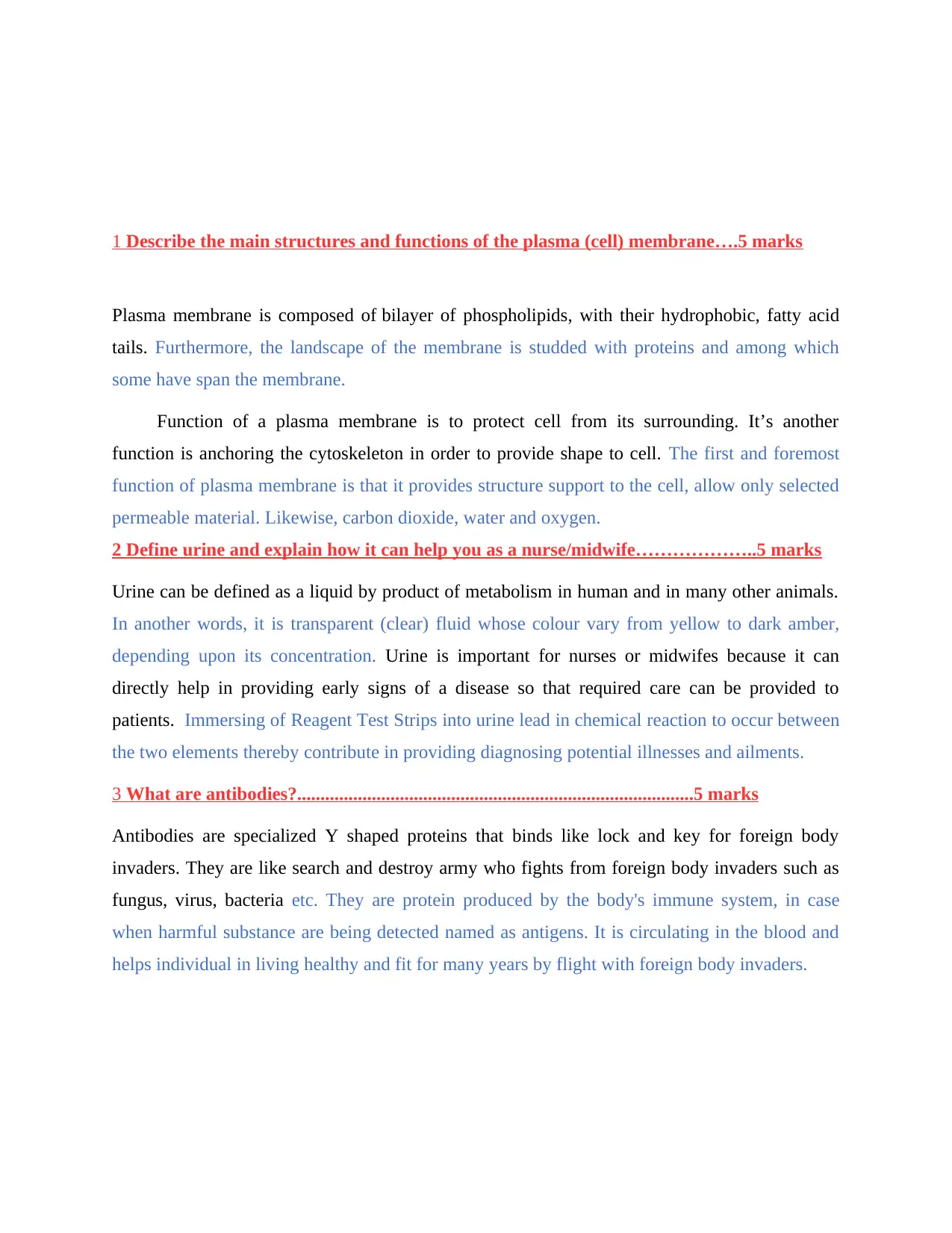
1 Describe the main structures and functions of the plasma (cell) membrane….5 marks
Plasma membrane is composed of bilayer of phospholipids, with their hydrophobic, fatty acid
tails. Furthermore, the landscape of the membrane is studded with proteins and among which
some have span the membrane.
Function of a plasma membrane is to protect cell from its surrounding. It’s another
function is anchoring the cytoskeleton in order to provide shape to cell. The first and foremost
function of plasma membrane is that it provides structure support to the cell, allow only selected
permeable material. Likewise, carbon dioxide, water and oxygen.
2 Define urine and explain how it can help you as a nurse/midwife………………..5 marks
Urine can be defined as a liquid by product of metabolism in human and in many other animals.
In another words, it is transparent (clear) fluid whose colour vary from yellow to dark amber,
depending upon its concentration. Urine is important for nurses or midwifes because it can
directly help in providing early signs of a disease so that required care can be provided to
patients. Immersing of Reagent Test Strips into urine lead in chemical reaction to occur between
the two elements thereby contribute in providing diagnosing potential illnesses and ailments.
3 What are antibodies?.....................................................................................5 marks
Antibodies are specialized Y shaped proteins that binds like lock and key for foreign body
invaders. They are like search and destroy army who fights from foreign body invaders such as
fungus, virus, bacteria etc. They are protein produced by the body's immune system, in case
when harmful substance are being detected named as antigens. It is circulating in the blood and
helps individual in living healthy and fit for many years by flight with foreign body invaders.
Plasma membrane is composed of bilayer of phospholipids, with their hydrophobic, fatty acid
tails. Furthermore, the landscape of the membrane is studded with proteins and among which
some have span the membrane.
Function of a plasma membrane is to protect cell from its surrounding. It’s another
function is anchoring the cytoskeleton in order to provide shape to cell. The first and foremost
function of plasma membrane is that it provides structure support to the cell, allow only selected
permeable material. Likewise, carbon dioxide, water and oxygen.
2 Define urine and explain how it can help you as a nurse/midwife………………..5 marks
Urine can be defined as a liquid by product of metabolism in human and in many other animals.
In another words, it is transparent (clear) fluid whose colour vary from yellow to dark amber,
depending upon its concentration. Urine is important for nurses or midwifes because it can
directly help in providing early signs of a disease so that required care can be provided to
patients. Immersing of Reagent Test Strips into urine lead in chemical reaction to occur between
the two elements thereby contribute in providing diagnosing potential illnesses and ailments.
3 What are antibodies?.....................................................................................5 marks
Antibodies are specialized Y shaped proteins that binds like lock and key for foreign body
invaders. They are like search and destroy army who fights from foreign body invaders such as
fungus, virus, bacteria etc. They are protein produced by the body's immune system, in case
when harmful substance are being detected named as antigens. It is circulating in the blood and
helps individual in living healthy and fit for many years by flight with foreign body invaders.
Paraphrase This Document
Need a fresh take? Get an instant paraphrase of this document with our AI Paraphraser
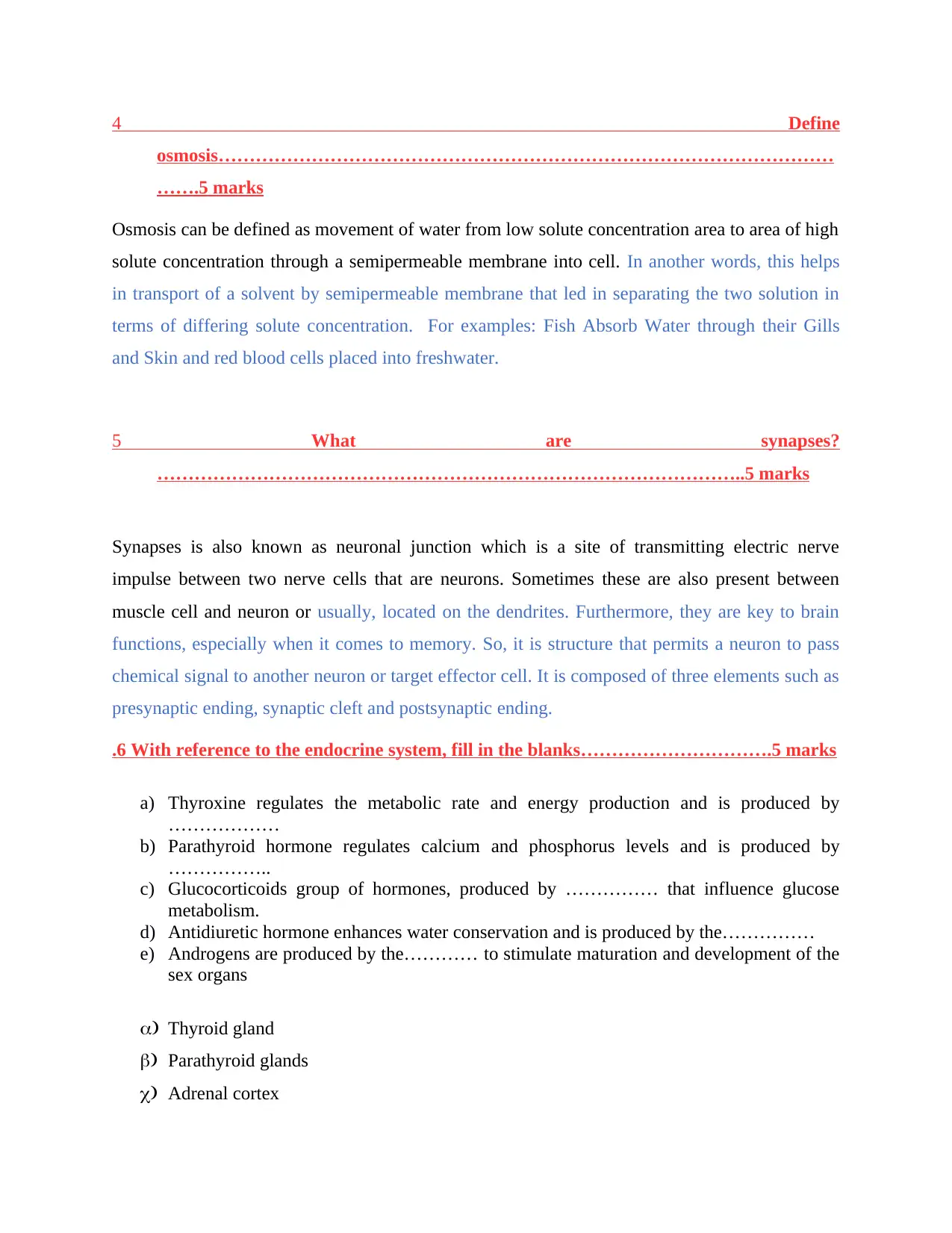
4 Define
osmosis………………………………………………………………………………………
…….5 marks
Osmosis can be defined as movement of water from low solute concentration area to area of high
solute concentration through a semipermeable membrane into cell. In another words, this helps
in transport of a solvent by semipermeable membrane that led in separating the two solution in
terms of differing solute concentration. For examples: Fish Absorb Water through their Gills
and Skin and red blood cells placed into freshwater.
5 What are synapses?
…………………………………………………………………………………..5 marks
Synapses is also known as neuronal junction which is a site of transmitting electric nerve
impulse between two nerve cells that are neurons. Sometimes these are also present between
muscle cell and neuron or usually, located on the dendrites. Furthermore, they are key to brain
functions, especially when it comes to memory. So, it is structure that permits a neuron to pass
chemical signal to another neuron or target effector cell. It is composed of three elements such as
presynaptic ending, synaptic cleft and postsynaptic ending.
.6 With reference to the endocrine system, fill in the blanks………………………….5 marks
a) Thyroxine regulates the metabolic rate and energy production and is produced by
………………
b) Parathyroid hormone regulates calcium and phosphorus levels and is produced by
……………..
c) Glucocorticoids group of hormones, produced by …………… that influence glucose
metabolism.
d) Antidiuretic hormone enhances water conservation and is produced by the……………
e) Androgens are produced by the………… to stimulate maturation and development of the
sex organs
a) Thyroid gland
b) Parathyroid glands
c) Adrenal cortex
osmosis………………………………………………………………………………………
…….5 marks
Osmosis can be defined as movement of water from low solute concentration area to area of high
solute concentration through a semipermeable membrane into cell. In another words, this helps
in transport of a solvent by semipermeable membrane that led in separating the two solution in
terms of differing solute concentration. For examples: Fish Absorb Water through their Gills
and Skin and red blood cells placed into freshwater.
5 What are synapses?
…………………………………………………………………………………..5 marks
Synapses is also known as neuronal junction which is a site of transmitting electric nerve
impulse between two nerve cells that are neurons. Sometimes these are also present between
muscle cell and neuron or usually, located on the dendrites. Furthermore, they are key to brain
functions, especially when it comes to memory. So, it is structure that permits a neuron to pass
chemical signal to another neuron or target effector cell. It is composed of three elements such as
presynaptic ending, synaptic cleft and postsynaptic ending.
.6 With reference to the endocrine system, fill in the blanks………………………….5 marks
a) Thyroxine regulates the metabolic rate and energy production and is produced by
………………
b) Parathyroid hormone regulates calcium and phosphorus levels and is produced by
……………..
c) Glucocorticoids group of hormones, produced by …………… that influence glucose
metabolism.
d) Antidiuretic hormone enhances water conservation and is produced by the……………
e) Androgens are produced by the………… to stimulate maturation and development of the
sex organs
a) Thyroid gland
b) Parathyroid glands
c) Adrenal cortex
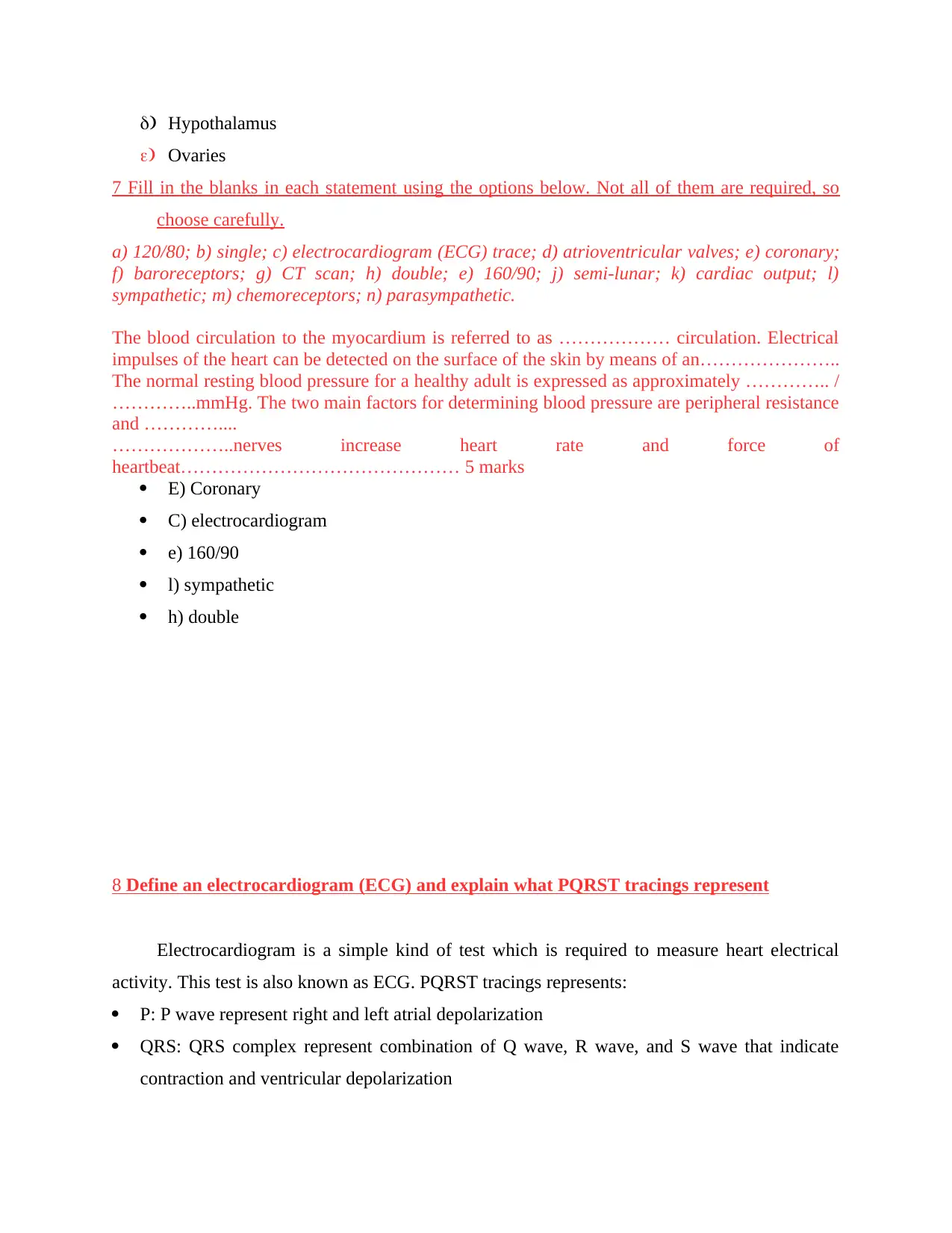
d) Hypothalamus
e) Ovaries
7 Fill in the blanks in each statement using the options below. Not all of them are required, so
choose carefully.
a) 120/80; b) single; c) electrocardiogram (ECG) trace; d) atrioventricular valves; e) coronary;
f) baroreceptors; g) CT scan; h) double; e) 160/90; j) semi-lunar; k) cardiac output; l)
sympathetic; m) chemoreceptors; n) parasympathetic.
The blood circulation to the myocardium is referred to as ……………… circulation. Electrical
impulses of the heart can be detected on the surface of the skin by means of an…………………..
The normal resting blood pressure for a healthy adult is expressed as approximately ………….. /
…………..mmHg. The two main factors for determining blood pressure are peripheral resistance
and …………....
………………..nerves increase heart rate and force of
heartbeat……………………………………… 5 marks
E) Coronary
C) electrocardiogram
e) 160/90
l) sympathetic
h) double
8 Define an electrocardiogram (ECG) and explain what PQRST tracings represent
Electrocardiogram is a simple kind of test which is required to measure heart electrical
activity. This test is also known as ECG. PQRST tracings represents:
P: P wave represent right and left atrial depolarization
QRS: QRS complex represent combination of Q wave, R wave, and S wave that indicate
contraction and ventricular depolarization
e) Ovaries
7 Fill in the blanks in each statement using the options below. Not all of them are required, so
choose carefully.
a) 120/80; b) single; c) electrocardiogram (ECG) trace; d) atrioventricular valves; e) coronary;
f) baroreceptors; g) CT scan; h) double; e) 160/90; j) semi-lunar; k) cardiac output; l)
sympathetic; m) chemoreceptors; n) parasympathetic.
The blood circulation to the myocardium is referred to as ……………… circulation. Electrical
impulses of the heart can be detected on the surface of the skin by means of an…………………..
The normal resting blood pressure for a healthy adult is expressed as approximately ………….. /
…………..mmHg. The two main factors for determining blood pressure are peripheral resistance
and …………....
………………..nerves increase heart rate and force of
heartbeat……………………………………… 5 marks
E) Coronary
C) electrocardiogram
e) 160/90
l) sympathetic
h) double
8 Define an electrocardiogram (ECG) and explain what PQRST tracings represent
Electrocardiogram is a simple kind of test which is required to measure heart electrical
activity. This test is also known as ECG. PQRST tracings represents:
P: P wave represent right and left atrial depolarization
QRS: QRS complex represent combination of Q wave, R wave, and S wave that indicate
contraction and ventricular depolarization
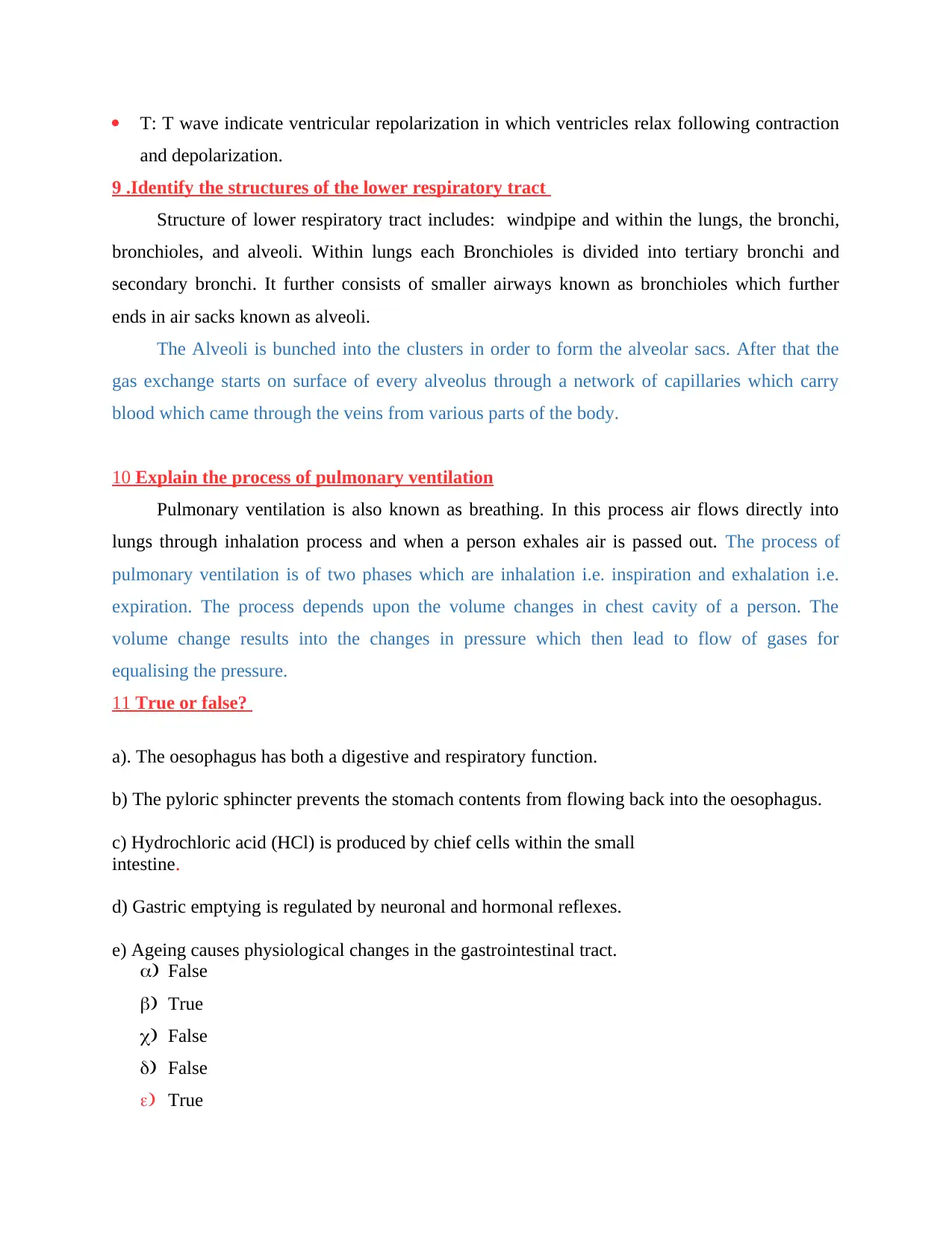
T: T wave indicate ventricular repolarization in which ventricles relax following contraction
and depolarization.
9 .Identify the structures of the lower respiratory tract
Structure of lower respiratory tract includes: windpipe and within the lungs, the bronchi,
bronchioles, and alveoli. Within lungs each Bronchioles is divided into tertiary bronchi and
secondary bronchi. It further consists of smaller airways known as bronchioles which further
ends in air sacks known as alveoli.
The Alveoli is bunched into the clusters in order to form the alveolar sacs. After that the
gas exchange starts on surface of every alveolus through a network of capillaries which carry
blood which came through the veins from various parts of the body.
10 Explain the process of pulmonary ventilation
Pulmonary ventilation is also known as breathing. In this process air flows directly into
lungs through inhalation process and when a person exhales air is passed out. The process of
pulmonary ventilation is of two phases which are inhalation i.e. inspiration and exhalation i.e.
expiration. The process depends upon the volume changes in chest cavity of a person. The
volume change results into the changes in pressure which then lead to flow of gases for
equalising the pressure.
11 True or false?
a). The oesophagus has both a digestive and respiratory function.
b) The pyloric sphincter prevents the stomach contents from flowing back into the oesophagus.
c) Hydrochloric acid (HCl) is produced by chief cells within the small
intestine.
d) Gastric emptying is regulated by neuronal and hormonal reflexes.
e) Ageing causes physiological changes in the gastrointestinal tract.
a) False
b) True
c) False
d) False
e) True
and depolarization.
9 .Identify the structures of the lower respiratory tract
Structure of lower respiratory tract includes: windpipe and within the lungs, the bronchi,
bronchioles, and alveoli. Within lungs each Bronchioles is divided into tertiary bronchi and
secondary bronchi. It further consists of smaller airways known as bronchioles which further
ends in air sacks known as alveoli.
The Alveoli is bunched into the clusters in order to form the alveolar sacs. After that the
gas exchange starts on surface of every alveolus through a network of capillaries which carry
blood which came through the veins from various parts of the body.
10 Explain the process of pulmonary ventilation
Pulmonary ventilation is also known as breathing. In this process air flows directly into
lungs through inhalation process and when a person exhales air is passed out. The process of
pulmonary ventilation is of two phases which are inhalation i.e. inspiration and exhalation i.e.
expiration. The process depends upon the volume changes in chest cavity of a person. The
volume change results into the changes in pressure which then lead to flow of gases for
equalising the pressure.
11 True or false?
a). The oesophagus has both a digestive and respiratory function.
b) The pyloric sphincter prevents the stomach contents from flowing back into the oesophagus.
c) Hydrochloric acid (HCl) is produced by chief cells within the small
intestine.
d) Gastric emptying is regulated by neuronal and hormonal reflexes.
e) Ageing causes physiological changes in the gastrointestinal tract.
a) False
b) True
c) False
d) False
e) True
Secure Best Marks with AI Grader
Need help grading? Try our AI Grader for instant feedback on your assignments.
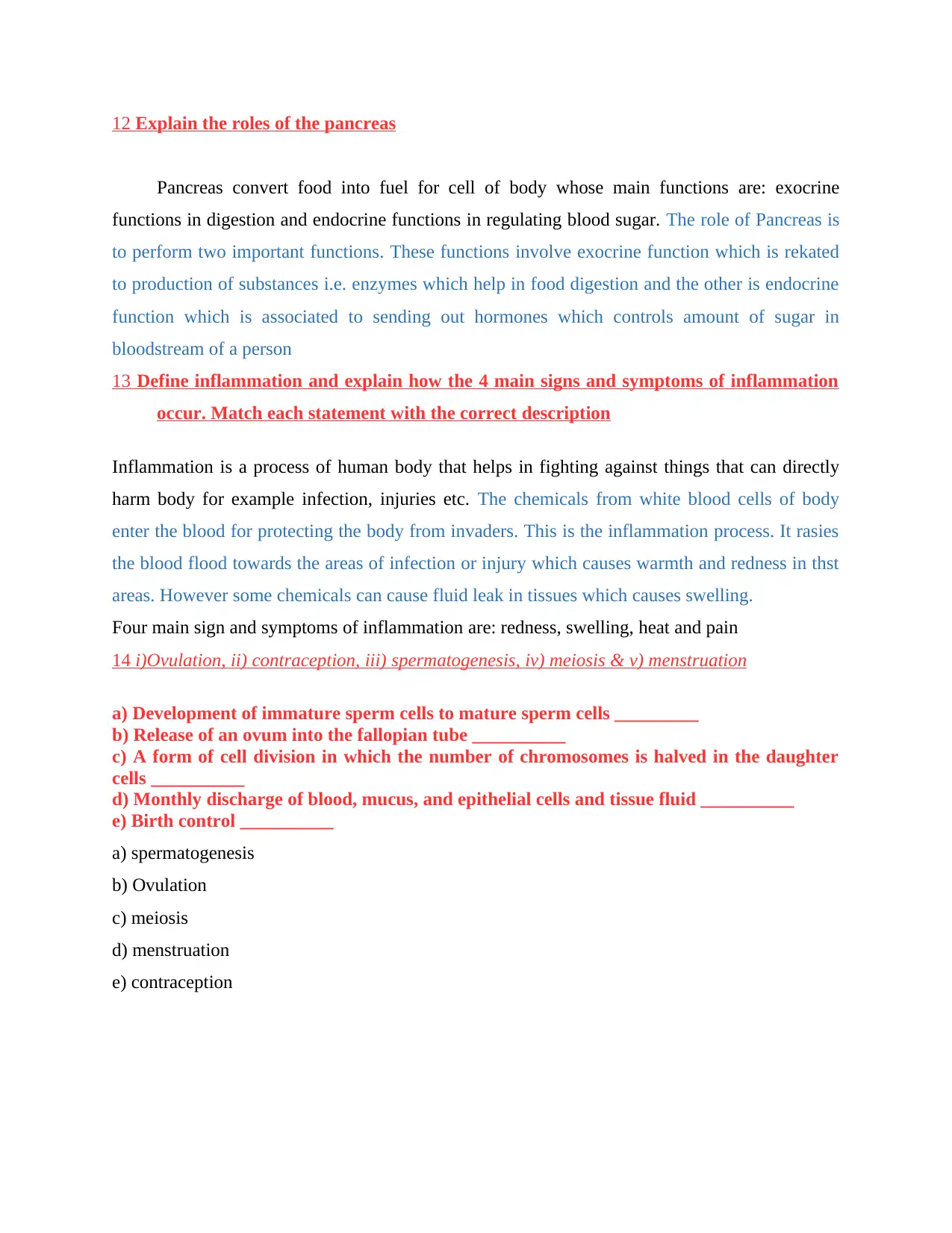
12 Explain the roles of the pancreas
Pancreas convert food into fuel for cell of body whose main functions are: exocrine
functions in digestion and endocrine functions in regulating blood sugar. The role of Pancreas is
to perform two important functions. These functions involve exocrine function which is rekated
to production of substances i.e. enzymes which help in food digestion and the other is endocrine
function which is associated to sending out hormones which controls amount of sugar in
bloodstream of a person
13 Define inflammation and explain how the 4 main signs and symptoms of inflammation
occur. Match each statement with the correct description
Inflammation is a process of human body that helps in fighting against things that can directly
harm body for example infection, injuries etc. The chemicals from white blood cells of body
enter the blood for protecting the body from invaders. This is the inflammation process. It rasies
the blood flood towards the areas of infection or injury which causes warmth and redness in thst
areas. However some chemicals can cause fluid leak in tissues which causes swelling.
Four main sign and symptoms of inflammation are: redness, swelling, heat and pain
14 i)Ovulation, ii) contraception, iii) spermatogenesis, iv) meiosis & v) menstruation
a) Development of immature sperm cells to mature sperm cells _________
b) Release of an ovum into the fallopian tube __________
c) A form of cell division in which the number of chromosomes is halved in the daughter
cells __________
d) Monthly discharge of blood, mucus, and epithelial cells and tissue fluid __________
e) Birth control __________
a) spermatogenesis
b) Ovulation
c) meiosis
d) menstruation
e) contraception
Pancreas convert food into fuel for cell of body whose main functions are: exocrine
functions in digestion and endocrine functions in regulating blood sugar. The role of Pancreas is
to perform two important functions. These functions involve exocrine function which is rekated
to production of substances i.e. enzymes which help in food digestion and the other is endocrine
function which is associated to sending out hormones which controls amount of sugar in
bloodstream of a person
13 Define inflammation and explain how the 4 main signs and symptoms of inflammation
occur. Match each statement with the correct description
Inflammation is a process of human body that helps in fighting against things that can directly
harm body for example infection, injuries etc. The chemicals from white blood cells of body
enter the blood for protecting the body from invaders. This is the inflammation process. It rasies
the blood flood towards the areas of infection or injury which causes warmth and redness in thst
areas. However some chemicals can cause fluid leak in tissues which causes swelling.
Four main sign and symptoms of inflammation are: redness, swelling, heat and pain
14 i)Ovulation, ii) contraception, iii) spermatogenesis, iv) meiosis & v) menstruation
a) Development of immature sperm cells to mature sperm cells _________
b) Release of an ovum into the fallopian tube __________
c) A form of cell division in which the number of chromosomes is halved in the daughter
cells __________
d) Monthly discharge of blood, mucus, and epithelial cells and tissue fluid __________
e) Birth control __________
a) spermatogenesis
b) Ovulation
c) meiosis
d) menstruation
e) contraception

15. In reference to your chosen professional discipline explain how an understanding of
anatomy, physiology and pharmacology will enhance your practice.
As a nurse understanding of anatomy, physiology and pharmacology can directly help me in
understanding functioning of human body, body parts, structure of body and drugs or
medications that can be provided to patients in diseases can be understood in an appropriate
manner. This can further help me in providing high quality and appropriate care to patient.
The understanding of anatomy and physiology can assist the nurse in comprehending to take
good care of the patients. I can enable a nurse to act quickly in the time of emergency without
waiting for the doctor to check in at the time of critical need of care.
16 This Punnett square shows the percentage risk this couple, who are both carriers of the
cystic fibrosis gene, has of having children with cystic fibrosis. What percentage risk
do they have of having children who will be carriers but not have the
disease?..................................5 marks
Percentage of risk children have who are carriers but do not have disease is 25 percent
EXAMPLES OF PHARMACOLOGY QUESTIONS
EXAMPLES OF PHARMACOLOGY QUESTIONS.
(You will be given 10 drugs to study 4 weeks before the exam; you will be required to
answer only 3 in the exam; NOTE: these are only example questions & may be different in
the actual exam)
For each of the three medications, paracetamol, insulin & amoxycillin, please briefly describe
anatomy, physiology and pharmacology will enhance your practice.
As a nurse understanding of anatomy, physiology and pharmacology can directly help me in
understanding functioning of human body, body parts, structure of body and drugs or
medications that can be provided to patients in diseases can be understood in an appropriate
manner. This can further help me in providing high quality and appropriate care to patient.
The understanding of anatomy and physiology can assist the nurse in comprehending to take
good care of the patients. I can enable a nurse to act quickly in the time of emergency without
waiting for the doctor to check in at the time of critical need of care.
16 This Punnett square shows the percentage risk this couple, who are both carriers of the
cystic fibrosis gene, has of having children with cystic fibrosis. What percentage risk
do they have of having children who will be carriers but not have the
disease?..................................5 marks
Percentage of risk children have who are carriers but do not have disease is 25 percent
EXAMPLES OF PHARMACOLOGY QUESTIONS
EXAMPLES OF PHARMACOLOGY QUESTIONS.
(You will be given 10 drugs to study 4 weeks before the exam; you will be required to
answer only 3 in the exam; NOTE: these are only example questions & may be different in
the actual exam)
For each of the three medications, paracetamol, insulin & amoxycillin, please briefly describe

i. where and how this medication work…………………………………………2 marks
ii. 1 side effect of this medication………………………………………………..1.mark
iii. 2 examples of how you might monitor the effect of this medication………3 marks
OR
PHARMACOLOGY QUESTIONS MAY VARY EG
1. with reference to anatomy and physiology, where and how does this medication
work…………………………………………………………………………………2 marks
2. explain how you will monitor if this medication is benefitting or harming your
patients……………………………………………………………………………..3 marks.
Paracetamol
Where and how this medication work
It works in brain by blocking chemical messengers that tell brain that body have pain. By
affecting chemical messengers it also helps in reducing pain.
1 side effect of this medication
Allergic reaction that cause swelling and rash
In rare condition it can cause fast heartbeat and low blood pressure.
2 examples of ways in which one might monitor the effect of this medication
Reviewing effect of paracetamol after 24 hours and 48 hours.
By checking whether it was taken empty stomach or whether alcohol consumption has been
done with paracetamol.
Insulin
Where and how this medication work
This process take place in pancreas and helps in moving sugar into blood from other body
tissues
ii. 1 side effect of this medication………………………………………………..1.mark
iii. 2 examples of how you might monitor the effect of this medication………3 marks
OR
PHARMACOLOGY QUESTIONS MAY VARY EG
1. with reference to anatomy and physiology, where and how does this medication
work…………………………………………………………………………………2 marks
2. explain how you will monitor if this medication is benefitting or harming your
patients……………………………………………………………………………..3 marks.
Paracetamol
Where and how this medication work
It works in brain by blocking chemical messengers that tell brain that body have pain. By
affecting chemical messengers it also helps in reducing pain.
1 side effect of this medication
Allergic reaction that cause swelling and rash
In rare condition it can cause fast heartbeat and low blood pressure.
2 examples of ways in which one might monitor the effect of this medication
Reviewing effect of paracetamol after 24 hours and 48 hours.
By checking whether it was taken empty stomach or whether alcohol consumption has been
done with paracetamol.
Insulin
Where and how this medication work
This process take place in pancreas and helps in moving sugar into blood from other body
tissues
Paraphrase This Document
Need a fresh take? Get an instant paraphrase of this document with our AI Paraphraser

1 side effect of this medication
Dizziness, fast heart rate
2 examples of ways in which one might monitor the effect of this medication
by testing blood sugar level with the help of instrument
with the help of blood test
Amoxycillin
Where and how this medication work
it works at area where infection has been caused by bacteria such as at lungs, ear, skin etc. It
helps in stopping growth of bacteria
1 side effect of this medication
Vomiting
2 examples of ways in which one might monitor the effect of this medication
by observing colour of urine, presence of vomiting, healing of infection
Dizziness, fast heart rate
2 examples of ways in which one might monitor the effect of this medication
by testing blood sugar level with the help of instrument
with the help of blood test
Amoxycillin
Where and how this medication work
it works at area where infection has been caused by bacteria such as at lungs, ear, skin etc. It
helps in stopping growth of bacteria
1 side effect of this medication
Vomiting
2 examples of ways in which one might monitor the effect of this medication
by observing colour of urine, presence of vomiting, healing of infection

1
1 out of 21
Related Documents
Your All-in-One AI-Powered Toolkit for Academic Success.
+13062052269
info@desklib.com
Available 24*7 on WhatsApp / Email
![[object Object]](/_next/static/media/star-bottom.7253800d.svg)
Unlock your academic potential
© 2024 | Zucol Services PVT LTD | All rights reserved.
